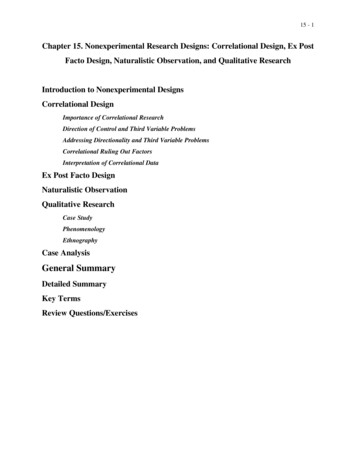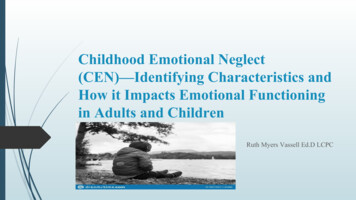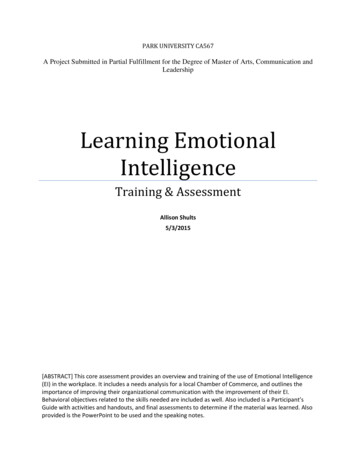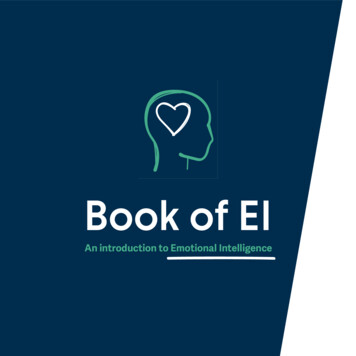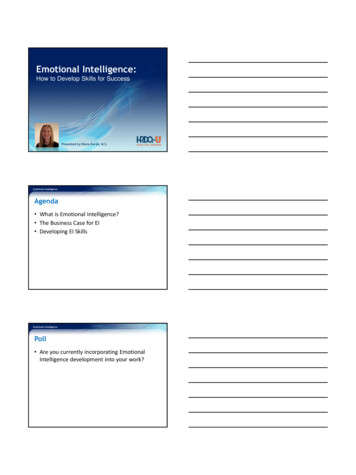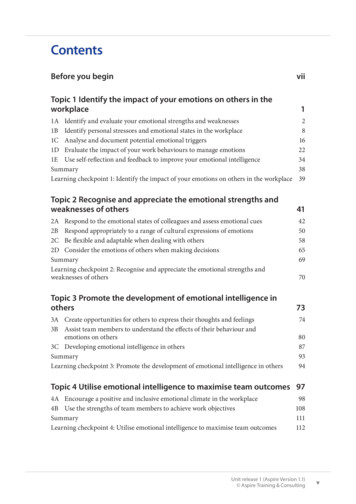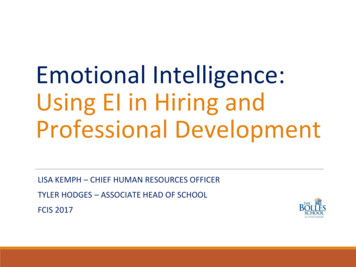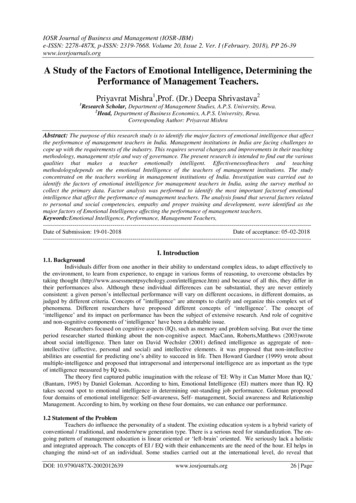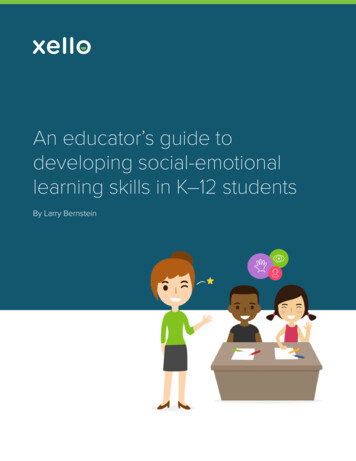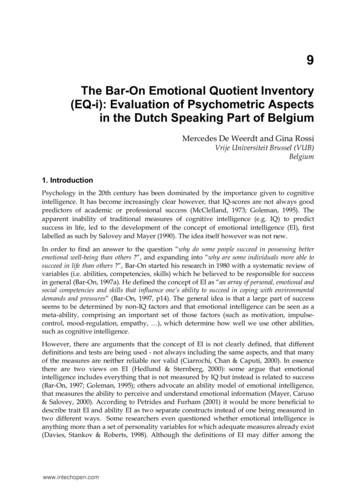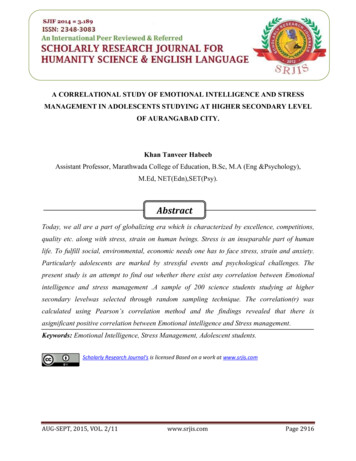
Transcription
SRJIS/BIMONTHLY/ KHAN TANVEER HABEEB (2916-2928)A CORRELATIONAL STUDY OF EMOTIONAL INTELLIGENCE AND STRESSMANAGEMENT IN ADOLESCENTS STUDYING AT HIGHER SECONDARY LEVELOF AURANGABAD CITY.Khan Tanveer HabeebAssistant Professor, Marathwada College of Education, B.Sc, M.A (Eng &Psychology),M.Ed, NET(Edn),SET(Psy).AbstractToday, we all are a part of globalizing era which is characterized by excellence, competitions,quality etc. along with stress, strain on human beings. Stress is an inseparable part of humanlife. To fulfill social, environmental, economic needs one has to face stress, strain and anxiety.Particularly adolescents are marked by stressful events and psychological challenges. Thepresent study is an attempt to find out whether there exist any correlation between Emotionalintelligence and stress management .A sample of 200 science students studying at highersecondary levelwas selected through random sampling technique. The correlation(r) wascalculated using Pearson’s correlation method and the findings revealed that there isasignificant positive correlation between Emotional intelligence and Stress management.Keywords: Emotional Intelligence, Stress Management, Adolescent students.cScholarly Research Journal's is licensed Based on a work at www.srjis.comAUG-SEPT, 2015, VOL. 2/11www.srjis.comPage 2916
SRJIS/BIMONTHLY/ KHAN TANVEER HABEEB (2916-2928)IntroductionThe problem of stress an adjustment is widely seen as a social crisis as well as a problem ofindividual behavior. When an individual does not succeed in his work regularly then he comesunder the area of stress and maladjustment. The concept of emotional intelligence can be usedeffectively in solving these problems and helps the individual to adjust in the society. In therecent years, a great interest in emotional intelligence on the part of corporations, universitiesand schools have been seen. The idea of emotional intelligence has inspired research andcurriculum development to improve educational curriculum and incorporate these principles intoeverybody learning for students. Building one’s emotional intelligence has a lifelong impact.Many parents and educators, alarmed by increasing levels of conflict in young school childrenfrom low self-esteem to early drug and alcohol use to depression, are rushing to teach studentsthe skills necessary for emotional intelligence.Emotional Intelligence: The Development of the ConceptThe origin of Emotional Intelligence can be traced back to the 17th century with Spinoza (1677)suggesting that emotion and intelligence together contributed to the ultimate cognitive tool.Emotional component to intelligence and cognitive effectiveness can be traced back to the greatphilosophers of antiquity and the notion of EI as a science back to E. L Thorndike’s (1920)comments on the possibility of “social intelligence” in the early 20th century.Thorndike (1920)classified intelligence into three broad categories; abstract/verbal, visual/ spatial and social/practical. The third type of intelligence called “social intelligence” suggested by him,is acapacity to understand people and act wisely in human relations.Gardner (1983) in his book Frames of Mind, put forward the argument that there must be morethan traditional types of intelligence to explain success in life. He emphasized the importance ofinter- and intrapersonal intelligences.Sternberg (1985) agreed with the concept of social intelligence and said that it is not only distinctfrom academic abilities but also an integral part of what makes people do well in thepracticalities of life. He noted that conventional IQ tests assess only analytical aspects ofintelligence. People who are defined as intelligent according to the classical concept of may notbe successful in life whereas many with IQs in the middle-normal range can succeed to a highdegree. Researches reveal that there are other psychological traits that are predictive of success.Sternberg (1985) called this aspect of personality “practical intelligence.”AUG-SEPT, 2015, VOL. 2/11www.srjis.comPage 2917
SRJIS/BIMONTHLY/ KHAN TANVEER HABEEB (2916-2928)Gardner (1999) defined interpersonal intelligence as having the capacity to “understand theintentions, motivations, and desires of other people and, consequently, to work effectively withothers” and intrapersonal intelligence as “the capacity to understand oneself, to have an effectiveworking model of oneself – including one’s own desires, fears, and capacities – and to use suchinformation effectively in regulating one’s own life”. He specifically identified salespeople,teachers, clinicians, religious leaders, political leaders, and actors; as the people who need “acuteinterpersonal intelligence”.Definitions and Meaning of emotional intelligence:According to Kate Cannon, Creator of first emotional intelligence programme in theAmerican Express Financial Services, “Emotional Intelligence is about using the power ofemotion as a source of information,motivation and connection.”Emotional intelligence refers to the capacity for recognizing our own feelings and those of othersfor motivating ourselves and for managing emotions well in ourselves and our relationships(Goleman, 1998).Dimensions of Emotional Intelligence given by Daniel GolemanDaniel Goleman in his second book on Emotional Intelligence ‘Working with EmotionalIntelligence’ has given five domains for Emotional Intelligence. The five domains are:1. Self -Awareness2. Self- Regulation or Managing Emotions3. Motivating Oneself4. Empathy5. Handling Relationships or Social Skills.Definition of Stress Management:“Stress management is the ability and skill to choose and exercise healthy self- control and selfmanagement in response to stressful events (Nelson & Low, 1998).”This meta-factor comprises Stress Tolerance and Impulse Control. This component ofemotional-social intelligence relates primarily to emotional management and control and governsour ability to deal with emotions so that they work for us and not against us. People who areadept in this area are able to withstand and effectively cope with stress without losing control.They are typically calm, rarely impulsive and work well under pressure. They can handle tasksthat are stressful, anxiety-provoking and even dangerous.AUG-SEPT, 2015, VOL. 2/11www.srjis.comPage 2918
SRJIS/BIMONTHLY/ KHAN TANVEER HABEEB (2916-2928)Emotional intelligence and Stress management:EI has strong relationship with individual’s ability to cope with their environmental stressors.Some previous studies show that people with different level of emotional intelligence preferdifferent styles of coping strategies: Higher EI is correlated with higher satisfaction with life,better perceived problem-solving coping ability and significant relationship between problemsolving and seeking social support, as well as problem solving and dimension of EI (self):selfawareness, motivation, empathy and social skill and stress also showed relationship withemotional intelligence(manager); motivation, empathy and social skill (Bastian, 2005; Estelle,2009)Coping can also be described as thoughts, behaviors, or may be strategies that are used tomanage a negative or stressful event like an academic failure (Lazarus and Folkman, 1987;KaminsandDweck, 1999; Folkman and Moskowitz, 2004). Folkman and Lazarusdefinedcoping as activities undertaken to tolerate, reduce, master, or minimize environmental orintrapsychic demands perceived to represent potential threats, existing harm, or losses andcoping is highly contextual, since to be effective it must change over time and across differentstressful condition. Specific behaviors which are used in dealing with a stressor and may even beconsidered independent of outcome is known coping strategy. (Folkman and Lazarus,1985).Stress management in Adolescence“Adolescence is that period between childhood and adulthood which can itself be divided intodevelopmental stages. Regardless of developmental stage, adolescence is set to face changes ofboth a physiological and psychological nature, often with movement towards independence andexplorations of identity. Early adolescence is marked by a number of changes, including rapidcognitive, social, emotional and physical changes involving maturation. There are transitions inschool life, peer and family relationships and a likely increase in conflicts within the family,characteristically with parents. These conflicts mark the early and middle adolescent years andare generally superseded in late adolescence when parent child relationships become moresettled. The later adolescent years are generally marked by a greater interest in peer relationshipsand the striving to achieve goals and milestones that determine the directions for an adult future”.Adolescence is a period of development and change. There are intrapersonal changes such ascognitive development, maturation and emotional development and interpersonal changes suchas negotiating relationships with peers and family and adapting to school changes. There is aAUG-SEPT, 2015, VOL. 2/11www.srjis.comPage 2919
SRJIS/BIMONTHLY/ KHAN TANVEER HABEEB (2916-2928)growing importance of peer relationships as adolescence is traversed. Adolescent stressors fallinto three categories: achievement related concerns, relationship concerns and social issues.Whilst relationship-related concerns are important for adolescents, they are also concerned aboutgetting on in the world and about issues relating to the world in general. There is a clearrelationship between long-term stress and negative health outcomes.(cited from S.K Mangal’sEssentials of Educational Psychology)Stress is associated with impairment of health, and negative emotional experiences which isdetrimental to quality of life and sense of well-being (Sinha, 2000).According to Hall (1904)adolescent period is accompanied by disturbance and emotional instability, and he attributed thisto psychological, physical and physiological changes leadings to confusion and poor self concept.).Need and Significance of the ResearchAccording to Hall (1904) adolescent period is accompanied by disturbance and emotionalinstability, and he attributed this to psychological, physical and physiological changes leadings toconfusion and poor self- concept. Emotions are the main force, which enables an organism tocope with circumstances and add color and spice to our living. Emotional Intelligence representthe most set of skills that are needed to survive as a human being ,and to experience life to thefull Emotional intelligence will predict who succeeds and who doesn’t, who lives a life of painand who copes ,who is happy and who is miserable ,who has long term relationships and wholives in solitude. Emotional intelligence is the ability to sense and use emotions to moreeffectively, manage ourselves and influence positive outcomes in our relationships with others.So intelligence one shows, when the person is emotional,is Emotional intelligenceTaylor, (2002)stated that the high emotional intelligence people have skills that help them towards success inthe various spheres of life both at word and family, emotional intelligence is an ability to monitorone’s own and other emotions , to discriminate among them and to use the information to guideone’s thinking and actions (Salovey& Mayer, 1990).Review of related literaturePtacek, Smith & Dodge (1994) reported that men tend adopt more problem focused copingstrategies whereas women tend to adopt more emotion focused coping strategies and seek socialsupport.AUG-SEPT, 2015, VOL. 2/11www.srjis.comPage 2920
SRJIS/BIMONTHLY/ KHAN TANVEER HABEEB (2916-2928)Problem focused coping brings out positive results when the source of stress is manageablewhereas poorer results when it is not (Lester, Smart & Baum,1994).Pekrun et al. (2002) reported that positive emotions facilitate flexible and creative ways ofthinking, problem solving, and coping. They perceived coping in the light of the cognitivemotivational-relational theory of emotion.Parker et al. (2004) found some support for emotional intelligence factors and academicperformance.Pathan and Bansibihari (2004) studied the level of emotional intelligence in secondary teachersin relation to gender and age, ranging from 24 to 56 years of age. The results revealed that 98.4%teachers fall under ‘low’ category of emotional intelligence. There is no significant differencebetween the emotional intelligence of male and female teachers and emotional intelligence isindependent of age.Objectives of the study1. To assess the Emotional intelligence in the Adolescents of Aurangabad city.2. To assess the level of stress management in the Adolescents of Aurangabad city3. To assess the Emotional intelligence in the Adolescents with respect to following dimensions: Intrapersonal Awareness. Interpersonal Awareness. Intrapersonal Management. Interpersonal Management.4. To study the correlation between Emotional intelligence and Stress Management.Hypotheses1. The Emotional intelligence in the Adolescents of Aurangabad city is high.2. The level of stress management in the Adolescents of Aurangabad city is high.3. The Intra-personal Awareness in the Adolescents of Aurangabad city is high.4. The Inter-personal Awareness in the Adolescents of Aurangabad city is high5. The Intra-personal Management in the Adolescents of Aurangabad city is high6. The Inter-personal Management in the Adolescents of Aurangabad city is high7. Thecorrelation between Emotional intelligence and Stress Management is significantlypositive.Research Method:AUG-SEPT, 2015, VOL. 2/11www.srjis.comPage 2921
SRJIS/BIMONTHLY/ KHAN TANVEER HABEEB (2916-2928)A sample of 200 students studying at higher secondary stage (English medium) of Aurangabadcity were selected through random sampling technique. Emotional Intelligence Inventorydesigned and standardized by Dr. Shubra Mangal was used to measure Emotional Intelligence.For measuring the stress management level in the students a scale constructed and standardizedby Dr. Vandana Kaushik and Dr. Namrata Arora was used. For analyzing the data mean andPearson’s correlation method were used as the statistical measures.Methodology Adopted for the studyDescriptive survey method was adopted for the research study.Results:TableNo.1.Table showing the Standard Scores, Obtained scores and Interpretation forEmotional Intelligence.Sr.NoRangescoresof InterpretationObtained Scoreofstandardscores1.2.3.4.5.Below 56.90InterpretationAverageTable.no.2: Table showing the Standard scores, Obtained Mean Scores and Interpretationfor the Components of Emotional reness3.Intra-PersonalManagement24 &above20-2314-1910-139 &below25 &above20-2414-1910-139 & below25 &AboveV. GoodGoodAveragePoorV.PoorV. GoodGoodAveragePoorV.PoorV. Good21-24GoodAUG-SEPT, 2015, VOL. 2/11and ge13.70Average12.20PoorPage 2922
SRJIS/BIMONTHLY/ KHAN TANVEER HABEEB (2916-2928)4.Inter-PersonalManagement16-2012-1511 & below25 & Above21-2416-2012-1511 &belowAveragePoorV.PoorV. GoodGoodAveragePoorV.Poor15.60AverageTableNo.3. Standard Norm Table forStress Management.Sr.No1.2.3.4.5.6.7.Rangeof Scores146 and above134-145121-133105-12092-10480-9179 and belowGradesABCDEFGInterpretationExcellent ManagementV.Good ManagementGood ManagementModerate ManagementPoor ManagementV.Poor ManagementExcellentPoorManagementTableNo.4.Table showing the Obtained Mean Scores and Interpretation for StressManagementVariableObtained MeanInterpretation119.20Moderate ManagementStress ManagementTable5: Table showing the Correlation between Emotional Intelligence and rrelationAUG-SEPT, 2015, VOL. 2/11Rangeof correlationwww.srjis.comof InterpretationPage 2923
SRJIS/BIMONTHLY/ KHAN TANVEER HABEEB gement.0.20 to 0.40Lowpositivecorrelationandsignificant at 0.01 levelof significance.From the above obtained scores in Table No.1and 4 we can infer that the Adolescence studyingat higher secondary level possess Average Emotional Intelligence and Moderate StressManagement level.Analysis regarding the components of Emotional Intelligence was also done(Table No.2) and it was found that the students were Average in Intra-Personal Awareness, InterPersonal Awareness &Inter-Personal Management but poor in Intra-Personal Management.Themajor objective of the study was to study the correlation between Emotional Intelligence andStress management which was found to be low but significant (Table No.5).Discussions:1. The mean obtained for Emotional Intelligence was 56.90(TableNo.1) which whencompared to the standard norm table of the manual falls in the range of Average category. It canbe concluded that students possess average emotional intelligence and there is need to enhance it.Emotional intelligence is a learned and acquiredability as researched by various psychologistsand it is needed for effective adjustment with the surroundings as the research finding byEngelberg and Sjoberg (2004) who found that emotional intelligence was related quitestrongly to social adjustment. Emotionally intelligent adults make better decisions, they livewith integrity, and they use their emotions as a source of energy and direction. They are moreeffective at solving problems, they collaborate better, are more effective leaders, more consciousparents. Interestingly they are not always, “happier” – they are less depressed, but more aware ofboth comfortable and uncomfortable feelings.2. The mean obtained for Intra-Personal Awareness, the component of EmotionalIntelligence was 15.40 (TableNo.2) which when compared to the standard norm table of themanual for emotional intelligence falls in the range of Average category.3. The mean obtained forInter-Personal Awareness, the component of EmotionalIntelligence was 13.70 (TableNo.2) which when compared to the standard norm table of themanual for emotional intelligence falls in the range of Average categoryAUG-SEPT, 2015, VOL. 2/11www.srjis.comPage 2924
SRJIS/BIMONTHLY/ KHAN TANVEER HABEEB (2916-2928)4. The mean obtained forIntra-Personal Management, the component of EmotionalIntelligence was 12.20 (TableNo.2) which when compared to the standard norm table of themanual for emotional intelligence falls in the range of poor category.5. The mean obtained for Inter-Personal Management, the component of EmotionalIntelligence was 15.60 (TableNo.2) which when compared to the standard norm table of themanual for emotional intelligence falls in the range of Average category. There is a need toenhance the various dimensions of emotional intelligence like Intra-Personal Awareness, InterPersonal Awareness, Intra-Personal Management and Inter-personal Managementwhich will escents.SinhaandJain(2004)conducted a study on emotional intelligence and its influence on relevant outcomes andreported that dimensions of emotional intelligence was meaningfully related with jobsatisfaction, personal effectiveness, organizational commitment, reputation effectiveness, generalhealth, trust, organizational effectiveness and organizational effectively .Fredrickson (2001)studied the functions of positive emotions in psychological health and well-being and has putforward that positive emotions, such as joy, interest, contentment, pride, and love, expandattention, cognition, and action.6. The mean obtained for stress management is 119.20 (TableNo.4) which when compared tothe standard norm table of the manual for stress management falls in the range of moderatecategory. It can be concluded that stress management level in the adolescents studying at highersecondary is of average level .There is a need to upgrade this level because it is a provenpsychological fact that Adolescence is a period of stress and strain and various researcheshas proven this fact like, According to Erikson (1968) psychosocial crisis of this period is egoidentity versus identity distortion. Unsatisfactory solution to this crisis can lead to increasedstress, anxiety and depression and will affect their self-efficacy to solve this crisis (identitycrisis) in an appropriate manner (Weiten, 2002). Arnett (1999) also pointed out that adolescentsexperience stress and disturbance more than any other age group.7. The correlation between Emotional Intelligence and Stress Management was found to be0.365(TableNo.5) which was low positive and significant at 0.01level of significance. Thisshows that there exists a positive and significant correlation between Emotional Intelligence andStress Management. This supports the research finding by Malek (2000) found a significantrelationship between emotional intelligence and conflict management style. Sehgel (1999)AUG-SEPT, 2015, VOL. 2/11www.srjis.comPage 2925
SRJIS/BIMONTHLY/ KHAN TANVEER HABEEB (2916-2928)conducted a study on adolescents and reported that psychological well-being showed highsignificant positive correlation with emotional intelligence quotient. Ciarrochi et al. (2000)found that emotional intelligence may protect people from stress and lead to better adaptation.Suggestions for students(1) Effectively manage emotions and develop an optimistic view of lifeCollege students should pay attention to their physical and mental health and examine theiremotions at all times to avoid onset of stress-induced depression or physical disorders. Besides,they should learn to understand, accept, and recognize themselves, take a positive attitude towardgetting along with their friends, learn to express and manage their emotions, and effectivelymanage their emotions so as to develop positive relations and an optimistic view of life. In theirlearning process, they should cultivate an undaunted spirit. Once any stress-induced emotionarises, they should relax the emotion through an appropriate channel, examine their ownproblems, and seek solutions. Suppression of emotions is not the only approach to controllingemotions. In face of stress, they can take a different perspective and learn to cope with it bychanging their views. Stress-induced emotions can be self-managed.(2) Increase stress management abilities and learn to seek supportCollege students should play an active role in stress management. On one hand, theycan learnvarious stress coping measures from various channels and transform anxiety or frustration causedby inadequate adaptation to stress. On the other, they should also enhance their emotionsmanagement abilities, monitor their emotions, and build their own emotions managementmodels. If any stress arises, they should analyze the causes of the stress from a positiveperspective and seek solutions or support from professional institutions.(3) Make use of family support and release stress-reduced emotionsFamily support is helpful for students faced with stress, no matter how they are adaptable to thestress. While college students should take advantage of family support, their family membersshould try to understand their interests, specialties, and abilities so as to avoid having too highexpectations of them and causing them additional stress.(cited from Cheng Kai-Wen,A study ofstress sources among college students in TaiwanJournal of Academic and Business Ethics,AStudy of Stress Sources)Suggestions for ParentsAUG-SEPT, 2015, VOL. 2/11www.srjis.comPage 2926
SRJIS/BIMONTHLY/ KHAN TANVEER HABEEB (2916-2928)Adolescent requires special attention. Their natural need to rebel, coupled with confusion andrage over what they have experienced, might make them especially difficult to reach in a time ofcrisis. Developing understanding that patience is needed to deal with adolescents tocommunicate and re-establish bonds and family members have to spend their qualitytime. Parents have to sacrifice their own social life in order to provide time for their children. Street disciplinary rules along with sympathetic dealing with their problems bring parentsand children closer to each other. Advices based on reasoning and factual in formations usually through an impact onadolescent’s mind. Grandparents can also provide social support, which gives adolescents social security andself- confidence to deal with their problems. Family members can also make their children aware of future problems and theirconsequences well in advance, along with the measures to deal with the problems.ReferencesBastian, V.A., N.R. Burnsand T. Nettelbeck.(2005),Emotional intelligence predicts life skills, but not as well as personality andcognitive abilities.Personality and Individual Differences 39(6):1135– 1145.Cheng Kai-Wen,A study of stress sources among college students inTaiwanJournal of Academic and Business Ethics, A Study of Stress Sources.Estelle, B.(2009).The relationship between occupational stress, emotionalintelligence and coping strategies in air traffic controllers.Dissertation of Master of Psychology,Stellenbosch UniversityFolkman, S. and R. S. Lazarus.(1985), If it changes it must be a process:Study of emotion and coping during three stages of a college examination. Journal ofPersonality and Social Psychology, 48(1): 150-170.Lazarus, R. S. andS. Folkman(1987),Transactional theory and research onemotions and coping. European journal of Personality, 1(3): 141-169 .Cooper, R.K. and Swarf, A. (1997) Executive EQ: Emotional Intelligencein Leadership and Organisations. New York: Grosset/Putnam.AUG-SEPT, 2015, VOL. 2/11www.srjis.comPage 2927
SRJIS/BIMONTHLY/ KHAN TANVEER HABEEB (2916-2928)Erikson, E.H. (1968). Identity: youth and crisis. New York: Norton.Fredrickson, B. L. (2001). The role of positive emotions in positivepsychology: The broaden-and-build theory of positive emotions. American Psychologist, 56,218-226.Gardner,H (1983).Frames of mind:The theory of multiple intelligences.New York: Basic Books.Goleman,Daniel.(1995),Emotional intelligence why it can matter more than IQ. New York:Bantam Books.Hall, G.S. (1904). Adolescence: its psychology and its relations tophysiology, Anthropology, sociology, sex, crime, religion and education (Vol. 1-2). New York:Appleton.Lester, N., Smart, L., & Baum, A.(1994).Measuring coping flexibility.Psychology and Health, 9, 409-424.Mayer, J. D., &Salovey, P. (1997). What is emotional intelligence? In P.Salovey& D. Sluyter (Eds.), Emotional development and emotional intelligence: Implications foreducators (pp. 3–31). New York: Basic.Pekrun, R., Goetz, T., Titz, W., & Perry, R. P. (2002).Positive emotions ineducation, In E. Frydenberg (Ed.), Beyond coping: Meeting goals, visions, and challenges (pp.149-173). New York: Oxford University Press.Sinha, U. K; Sharma, V. &Mahendra, K (2001). Development of a scale forassessing academic stress: A Parliamentary report. Journal of the institute of Medicine, 23:102105.Weiten, W. (2002). Psychology themes and variations, National library ofAustralia, 5th ed.: 208-212.AUG-SEPT, 2015, VOL. 2/11www.srjis.comPage 2928
Dimensions of Emotional Intelligence given by Daniel Goleman Daniel Goleman in his second book on Emotional Intelligence 'Working with Emotional Intelligence' has given five domains for Emotional Intelligence. The five domains are: 1. Self -Awareness 2. Self- Regulation or Managing Emotions 3. Motivating Oneself 4. Empathy 5.
